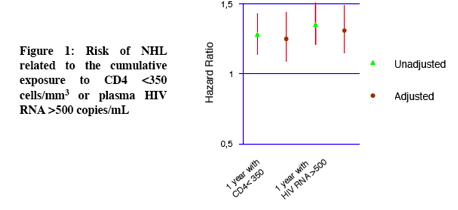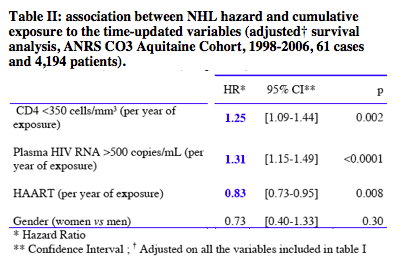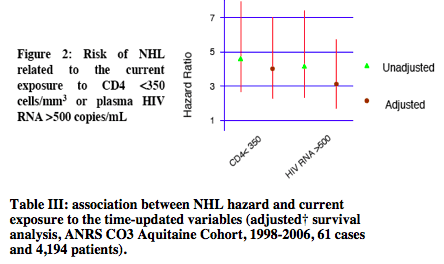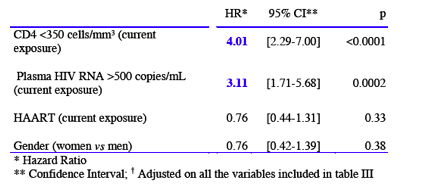 |
 |
 |
| |
Cumulative & Current Viral Replication & Low CD4 Increases NHL Risk: Immune deficiency, uncontrolled HIV replication and non-Hodgkin's lymphoma, ANRS CO3 Aquitaine Cohort, 1998-2006.
|
| |
| |
Reported by Jules Levin
IAS Capetown Juky 19-22 2009
M Bruyand1,2,, R Thiebaut1,2,3, S Lawson-Ayayi1,2, P Joly1,3, JL Pellegrin2,3,4, D Neau2,3,4, P Morlat1,2,3,4, S Geffard1, F Dabis1,2,3, G Chêne1,2,3, F Bonnet1,2,3,4
for the Groupe d'Epidemiologie Clinique du SIDA en Aquitaine (GECSA)1,2,3
1 INSERM U897, Bordeaux, F-33076, France ; 2 Centre Hospitalier Universitaire de Bordeaux, Coordination Regionale de la lutte contre l'infection due au VIH (COREVIH), Bordeaux, F-33076, France ; 3 Universite Victor Segalen Bordeaux 2, Bordeaux, F-33076, France ; 4 Services de Medecine Interne et Maladies Infectieuses, CHU de Bordeaux, F-33075 Bordeaux, France, mathias.bruyand@isped.u-bordeaux2.fr
BACKGROUND
Non-Hodgkin's lymphoma (NHL) remains one of the mains causes of death of HIV-infected patients, even if the incidence of this cancer has dramatically decreased since the availability of highly active antiretroviral therapy (HAART) [1]. The relationship between the risk of NHL and moderate immune deficiency, uncontrolled plasma HIV RNA and HAART remains incompletely investigated. We aimed at assessing the association between the hazard of NHL and immunological and virological characteristics of HIV-infected patients included in the ANRS CO3 Aquitaine Cohort.
AUTHOR DISCUSSION
These results show that both current and cumulative exposure to uncontrolled plasma HIV RNA viral load were independently associated
with a higher hazard of NHL, suggesting that the control of plasma HIV RNA is a key factor to prevent NHL occurrence. Cumulative and current exposure to CD4 <350 were associated with a higher hazard of NHL, underlining that following a prescription of HAART, the risk of NHL may decrease when the CD4 cell count rise above 350.
AUTHOR CONCLUSION
Current HAART, adjusted for current HIV RNA and CD4 cell count, does not add information. Nevertheless, longer HAART exposure could contribute to decrease NHL incidence. Longer and current exposure to CD4 <350 and VL >500 are associated with a higher hazard of NHL, underlining that the best possible control of HIV infection is warranted to prevent NHL occurrence.
METHODS
The ANRS CO3 Aquitaine Cohort is a French prospective hospital-based cohort of HIV1 infected patients under routine clinical management in South- West France; patients included in the cohort have given informed consent.
Patients without previous history of cancer and with at least:
- 3 months of follow-up
- 2 visit records available
-1 plasma HIV RNA and CD4 cell count reported during the study period
(1998-2006) were eligible for this study.
A confirmed diagnosis of NHL during the follow-up was the outcome.
The potential risk factors considered were:
-Time-updated variables (cumulative and current exposure):
-CD4 <350 cells/mm3
-Plasma HIV RNA >500 copies/mL
-HAART (defined as a regimen including at least 3 antiretroviral drugs)
-Fixed effect variable: gender
Extended Cox proportional hazards models for delayed entry (at the date of the first plasma HIV RNA/CD4 report) were used to perform the analysis. As age was considered as the time scale, it was not included as an own variable
in the models [2].
The follow-up of the patients affected by a non NHL cancer or still alive at the end of the study was right censored (at the date of diagnosis or on December, 31, 2006).
Adjusted analyses considered either the cumulative exposure to the time updated variables cited above, or the current exposure. The models were compared by using the Akaike criterion.
RESULTS
Among the 4,194 patients eligible, 61 NHL were diagnosed over the study period. The follow-up of 190 patients was right-censored due to another cancer diagnosis.
The incidence rate of NHL was 2.72 cases per 1000 person/years (95% Confidence Interval: 2.04-3.41).
Characteristics of the patients affected by NHL:
-77% were men
-At the time of diagnosis
-Median age was 40.4 years
-Median CD4 was 237 cells/mm3
-Median plasma HIV RNA was 4.4 Log copies/mL
Table 1 further describes these characteristics.
Cumulative exposure to the time-updated variables (table II, figure1):
Each year spent with CD4<350 or HIV RNA>500 was independently
associated with a higher hazard of NHL. Each year of HAART
exposure was related to a lower hazard of NHL, and gender was
independent of the risk of NHL. The AIC of this model was 764
Current exposure (table III, figure2):
CD4<350 and HIV RNA >500 were associated with a higher hazard of
NHL, but neither HAART nor gender were related to NHL hazard.
The AIC of this adjusted model was 748.
The difference between the AIC of the models considering cumulative and current exposures could be considered as negligible.





REFERENCES
1. Bonnet F et al. Clin Infect Dis. 2009; 48(5):633-9.
2. Commenges D et al. Am J Epidemiol 1997; 146:683-4.
|
| |
|
 |
 |
|
|